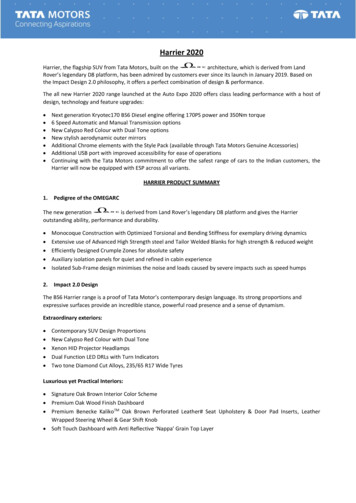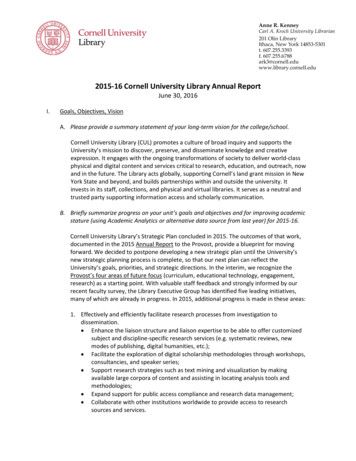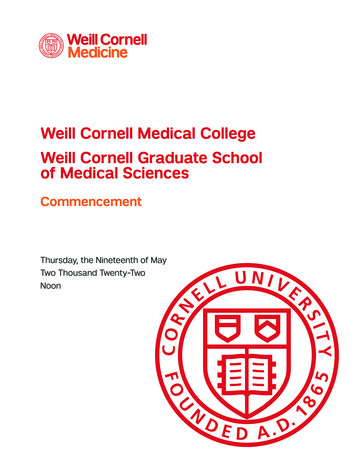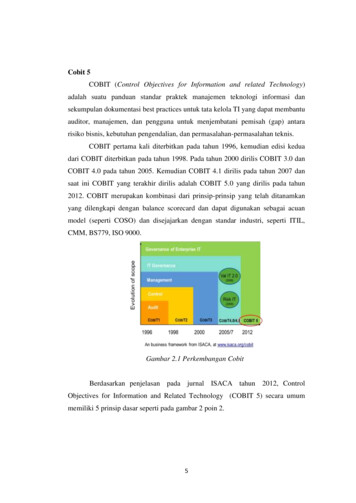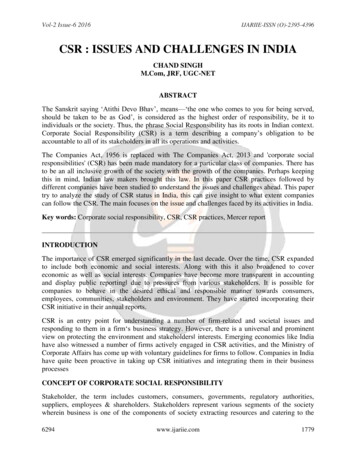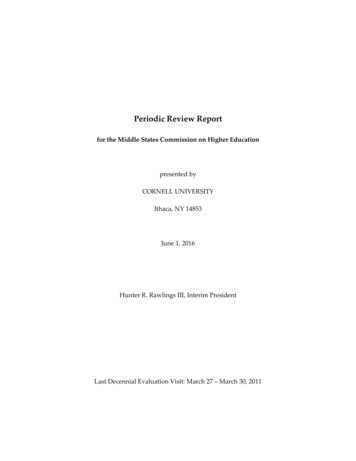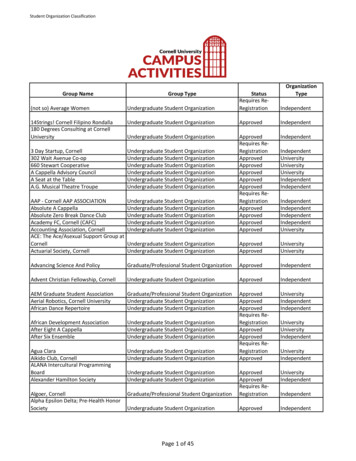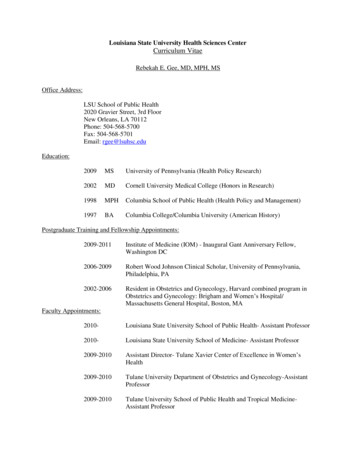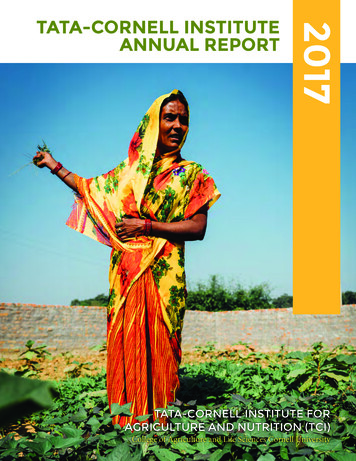
Transcription
ANNUAL REPORTANNUAL REPORTTATA-CORNELL INSTITUTE FORAGRICULTURE AND NUTRITION (TCI)College of Agriculture and Life Sciences Cornell University
FROM THE DIRECTOROVERVIEWRESEARCH HIGHLIGHTS2410- Sustainable Flour Fortification Initiative in Gujarat: Sfurti for aHealthier Life12- Sustainable Livestock Feeding Systems in the Face of IntensifyingGoat Production14- Understanding the Effects of Time Allocation Patterns of Women onNutrition in Rural India17- Access to Piped Water, Time Savings, and Diarrhea Incidence: Results fromField Survey in Jharkhand18- Igniting Change in Sanitation Behavior through Community-Led TotalSanitation20- A Participatory Approach to Mycotoxin Management in Village FoodSystems21- A Tasty Tuber to Tackle Vitamin A Deficiency in Uttar Pradesh22- Market–Farm Linkages: Producer Organizations and Private Value Chainsin Pulses24- Soil Health Program: Developing Mobile and Laboratory TestingPlatforms27- Exploring the Genetic and Environmental Factors of the Triple Burdenof Malnutrition28- Developing a Novel and Sustainable Fortified Food Product to AddressIron Malnutrition in India32- Quantity and Quality Losses along Fruit and Vegetable Value Chainsin India33- Diversity in Development: Interstate Differences in the Indian GrowthStory34- The Bumpy Road from Food to Nutrition Security37TARINA40- Year 2: Gaining Ground in the Fight Against Indian Malnutrition42- Thematic Areas: Ongoing Activities and Progress Achieved45- Looking Ahead57PERSONNEL AND PARTNERSTABLE OF CONTENTSTABLE OF CONTENTS581
FROM THEFROM THE DIRECTORDIRECTORFROM THE DIRECTORSince our inception in 2013, the Tata-CornellInstitute for Agriculture and Nutrition (TCI) hasgrown tremendously in size and in the scope ofresearch and operational work in India. Our workis starting to have an impact on food security andnutrition policy thinking in India and beyond. Weare now a multidisciplinary research group of 15Tata-Cornell Scholars, plus 4 Postdoctoral Fellowsand 2 Research Associates. In addition to ourIthaca-based research group, we have a growingpresence in our offices in Mumbai, New Delhi, andour field locations. The financial support providedby the generous endowment from the Tata Trustsenables us to think long-term and to conduct fieldbased research that produces real world solutionsto chronic poverty and food insecurity problemsfaced by rural communities. The four-year grantthat we received in 2015 from the Bill & MelindaGates Foundation allows us to operationalize ourresearch solutions and to take them to scale with anexpanded network of academic and NGO partnersin India.I am particularly proud of the multidisciplinarystrength of our research group and the rigorousfield-based research that is being conducted. TataCornell Scholars come from a variety of disciplines,including: Applied Economics, NutritionalSciences, Food Science, Animal Science, PlantPathology, and Soil Science. Intensive fieldwork,including randomized control trials, are currentlybeing conducted in India to address a multitudeof problems contributing to the poor nutritionalstatus of its population. Our scholars’ field researchincludes: the promotion of vitamin A rich orangefleshed sweet potato; the assessment of mycotoxinrisk and its mitigation in the food system; thedrinking water-health-nutrition nexus; women’sempowerment and nutritional outcomes; andbehavioral change interventions for promotingtoilet use in rural India. We believe that fieldresearch, which addresses the problems of the ruralpoor, can be compatible with the analytical rigorand academic excellence that is expected of Cornellgraduate students.I would like to take this opportunity toacknowledge the enormous support providedto us by the Mumbai-based Tata Institute ofSocial Sciences (TISS) and its Director ProfesssorParasuraman. Our close association with TISSenables the smooth functioning of our research andoperations in India. We have also been buildingacademic linkages with TISS, through facultyexchanges, seminars, and joint workshops. Thisyear, we simulcast a course being taught at CornellUniversity into TISS. Students in Mumbai couldparticipate in real time with students at Cornelland at the Nanjing Agricultural University in Chinain a course on the Food-Water-Energy nexus.TISS Professor Madhushree Shekar co-taught thiscourse along with myself and three other professorsfrom Cornell and a professor from Nanjing. Ilook forward to many more such “real-time” jointcourses with TISS and Cornell.Wethethesecondyearyearof theWehavehavecompletedcompletedsecondof Gatesthe GatesTATA-CORNELL INSTITUTE RESEARCH TEAMFrom left to right: Jocelyn Boiteau, Jessica Ames, Krystal Rampalli, VidyaBharathi Rajkumar, Payal Seth, Sri Raj, Anna David Thottappilly, NageshGavirneni, Maureen Valentine, Prankur Gupta, Prabhu Pingali, Kiera Crowley,Mathew Abraham, Andaleeb Rahman, Kavya Krishnan, Naveen Sunder,Fjolla Kondirolli, Rohil Bhatnagar, Vanisha Sharma, Anaka Aiyar, Megan Witwer.Not pictured (due to fieldwork): Shiuli Vanaja, Vidya Vemireddy, AnthonyWenndt, Kathryn dationgrant:TechnicalAssistanceand ResearchforResearch for Indian Nutrition and Agriculture(TARINA). TARINA promotes a em ina India throughsensitivea foodsystemin Indiaa consortiumconsortium ofofpartnersledledby byTCI.ThroughthisTCI.Throughpartnersthis consortium,mergesthe evidenceconsortium,TARINATARINAmerges theevidencegeneratinggeneratingofcapabilitiesof CornellUniversity,capabilitiesCornell University,EmoryUniversity, theEmory University, the International Food PolicyInternational Food Policy Research Institute (IFPRI), andResearch Institute (IFPRI), and TISS with theTISSwith thetechnical capabilitiesleadingtechnicalcapabilitiesof ns(NGOs) and developmentorganizations (NGOs)and dation,CAREIndiaSolutionsforSustainableCARE India Solutions for Sustainable Development,Development, Grameen Development ServicesGrameenDevelopment(GDS),thetwoTata(GDS), andthe Tata ServicesTrusts. OvertheandpastTrusts.the past twoyears, the TARINAhas beenconsortiumpromotingyears,Overthe systemsinhas been promoting the diversification of food I am Isystems in the states of Odisha, Bihar, and Uttar Pradesh.optimistic that this strong consortium will make aam optimistic that this strong consortium will make asignificant difference in the way future agriculturalIndian Nutrition and Agriculture (TARINA). TARINAsignificant difference in the way future agricultural projectsprojects in India are designed and implemented, inorder to explicitly incorporate nutrition outcomes.Through the efforts of TCI and TARINA, we arealso starting to influence the nutrition sensitivityof food and agriculture policy in India. A seriesof seminars and policy dialogues, held in Delhiand in Odisha in the last 12 months, have focusedon moving India’s food policy beyond its currentpreoccupation with staple grains to enhancingthe availability and access to a diverse set ofnutrition-rich foods. Several of our publicationshave also discussed the policy options for movingbeyond staple-grain fundamentalism. Our recentpublication, “The Bumpy Road from Food toNutrition Security—Slow Evolution of India’sFood Policy” in Global Food Security, has receivedconsiderable attention in India.As we enter our fifth year, I am optimistic thatTCI and TARINA are on the cusp of becomingsignificant forces for new research and policyadvocacy for nutrition-sensitive food systems.I hope you enjoy reading our Annual Report for2017.Sincerely,Dr. Prabhu PingaliDirectorin India are designed and implemented, in order to explicitly2incorporate nutrition outcomes.3
OVERVIEWOVERVIEW
OVERVIEWWe uniquely combine field-based projects,academic research, and policy analysis togenerate and share knowledge relevant toIndian policymakers, research institutions, anddevelopment agencies. Our institutional partnershave deep field experience and extensive knowledgeof the local context; by working together, we shareour strengths, mutually build our capacity, andrefine the quality of our joint projects. Foundedin 2013, with a generous gift from the Tata Trusts,we are well on our way to making meaningfuldiscoveries and developing innovative technologiesand policy solutions to address the agriculturenutrition nexus in India.PATHWAYS FOR LINKINGAGRICULTURE ANDNUTRITIONAlthough there are many approaches to improvinghealth and nutrition outcomes, TCI believes thatpathways that link agriculture and nutrition cancreate the most profound and lasting impactsfor good health. As such, we have identified andoriented our applied research along four keypathways:1. The income pathway, where gains inhousehold income can translate to better foodaffordability and other impacts;2. The food access pathway, including ahousehold’s access to sufficient, diverse, andquality food year round;3. The positive nutrition behavior pathway,where interventions attempt to equalizefood allocation among individuals withina common household and optimize earlychildhood care practices; and4. Nutrient absorption through improvements inthe health–environment pathway, which linksaccess to clean water and improved sanitationand hygiene practices to better nutritionalhealth.TCI’s research and projects in India consider thefactors that influence both a household’s ability toaccess food—such as income, employment, andthe ability to afford safe, high quality, and diversefoods in sufficient quantities—and the individual’sability to absorb and utilize his or her share of thehousehold’s total food/nutrient basket, which coulddiffer depending on the individual’s age, gender,level of empowerment, household dynamics,cultural practices, or even physiological life stage(e.g., pregnancy and infancy require different dietsand care practices).AGRICULTURE-NUTRITIONPATHWAYSTCI Conceptual FrameworkHOUSEHOLDFOOD ACCESS(Quantity, Quality andDiversity of Food)INDIVIDUALNUTRITION(Individual Intake andAbsorption of NurtientDense ovedIndividualNutrition andWell-BeingHouseholdAccess toDiverse FoodYear-RoundNutrientAbsorbtionSource: TCI 2014Figure 1: TCI Conceptual FrameworkThe income pathway and the food access pathwayhave the most direct connections to agriculture,given the dependency of the poor on theseactivities for their livelihood. Many TCI projectsfall under these pathways and are featured in thisyear’s annual report.INCOME PATHWAY ANDFOOD ACCESS PATHWAYThe Sustainable Flour Fortification Initiative(Sfurti) is designed to provide households withyear-round access to micronutrients (food accesspathway). TCI partnered with BAIF DevelopmentResearch Foundation, MS University of Baroda,and DSM to create a solution for micronutrientmalnutrition that would be sustainable overthe long run. Focusing on tribal communitiesin southern Gujarat and tapping into the socialmarketing potential of women’s self-help groups(SHGs), this program trains and empowers SHGmembers to sell sachets of multiple micronutrientpowder, generates consumer demand for suchsachets, and instructs community members andmillers on the proper mixing of the product intoflour. Income generated by selling the sachets isused by SHGs to resupply their inventory. In its firstyear (June 2016–June 2017), this campaign reached6,500 households, of which 70% voluntarily optedto buy the sachet branded as “Sfurti,“ which, inthe local language, means health. Beyond thefood access and income pathways, this programalso exemplifies TCI’s positive nutrition behaviorpathway, as behavior change communicationstrategies have been essential in raising awarenessand creating demand for this important solution tonutrient deficiency.Tata–Cornell Scholar Maureen Valentine alsoworks to address nutrition deficiencies, but as aPhD candidate in Animal Science, her researchwith TCI focuses on the feed and fodder for goats.These small ruminants are an important source offamily income, and in a country that largely doesnot eat beef, they are an important animal sourcefood for the population. Mrs. Valentine conducteda field experiment to test the idea that shiftingfrom an extensive, open-grazing system to asemi-intensive, stall-feeding system could increaseanimal feed efficiency and improve net incomefor farmers—as animals grow faster and producebetter quality milk, which supports the health anddevelopment of offspring. Indeed, results fromthis study showed that goat kid survival improvedin the stall-fed treatment group and that risk ofdeath for a goat kid in the control group was threetimes higher. Furthermore, of the farmers whoparticipated in the study, 25% said that they wantedto provide feeding alternatives to open grazing fortheir goats in the future. As livestock productionrises, management practices such as semi-intensivefeeding will be required to increase productionefficiency and to cope with diminishing land andforage available. Improvements to agriculturalextension networks, however, will be necessary ifsmallholder farmers are to expand and retain theirknowledge of best practices.OVERVIEWThe Tata-Cornell Institute for Agriculture andNutrition (TCI) is a long-term research initiativebased at Cornell University in Ithaca, New York,with offices in Mumbai and New Delhi, India.With a multidisciplinary team consisting ofapplied economists; nutritionists; food, plant,soil, and animal scientists; sociologists; engineers;and more, we are working to create, test, andscale up sustainable and effective solutions forreducing poverty and improving malnutrition andlivelihoods in rural India.Agricultural extension services are also essentialfor expanding knowledge about soil health.Livelihoods and household nutrition improve whensmall producers increase production efficiency;if we want to increase crop yield, we should notoverlook the basics: a healthy soil grows healthy,productive plants. Unfortunately, most farmersand many agronomists still focus exclusively onadding chemical fertilizers, whereas managingsoil health requires thinking holistically about thephysical, biological, and chemical attributes of soil.In the TCI Soil Health Project, we are working togive farmers and agricultural extension agents thetools and support they need to be able to measureand track indicators of soil health locally, throughthe development of a mobile soil health toolkit.This project will facilitate soil health assessment,education, and ultimately, conversation on soilhealth management practices. We have also beenbuilding awareness and capacity among Indiabased research institutions, universities, and NGOsin Cornell’s framework for the ComprehensiveAssessment of Soil Health.Another area of research that explores trends related to the income and food accessAnother area of research that explores trendsrelated to the income and food access pathwaysAbraham’sworkresponseon thepulsevalueisgrowingDr. Mathewthedemand for pulsesand the low supplyat thefarm levelhas ledtochain.uncertain pricesand low per capitaavailabilityof pulsesin the splitmarket. versification away from staple grains toward more nutrient-rich crops like pulses willand beans are critical to improving nutritiondepend on a small farm’s ability to commercialize. This study looks at the influenceoutcomes, and yet, the growing demand for pulsesthat aggregation models (such as farmer producer organizations (FPOs)) andand theresponse ve on commercialization.examiningnature of FPOuncertainpricesandvaluelowperhasledvalueto chainandprivateinterventionsin the pulseschain,we capitaassess how theypathways is Dr. Mathew Abraham’s work on the pulse value chain. Nutrient-rich foodslike lentils, split peas, and beans are critical to improving nutrition outcomes, and yet,can attempt to rectify the supply–demand mismatch.67
OVERVIEWPOSITIVE NUTRITIONBEHAVIOR PATHWAYEncouraging a more diversified food system willreduce micronutrient malnutrition and improvefood and nutrition security. Even as peopleachieve calorie-adequate diets, they may not attainnutrient-sufficient ones. In fact, micronutrientdeficiencies remain highly prevalent throughoutIndia. Beyond fortification, we believe diet-basedsolutions have great potential for sustainability,while remaining affordable.As such, TCI is undertaking a groundbreakingproject to test the effectiveness of orange-fleshedsweet potato in alleviating vitamin A deficiency(VAD) in villages in rural Uttar Pradesh. This work,led by Tata–Cornell Scholar Kathryn Merckel, willbuild on the notable successes of similar studies insub-Saharan Africa, for which the leading researchteams were awarded the 2016 World Food Prize.Understanding the potential of the orange-fleshedsweet potato, in the Indian context, to reducevitamin A deficiency will improve future diet-basedsolutions for decreasing VAD and influencingfood and agriculture policy, and build evidencethat promotion of micronutrient-rich vegetablesneed not be at the expense of calorie density in theIndian diet.We are also documenting and characterizingexisting nutrition behaviors. We have standardized502 recipes—in terms of ingredients used and thetime required to prepare and cook them—as apart of our ongoing research in the Chandrapurdistrict of Maharashtra. Tata–Cornell ScholarVidya Vemireddy is assessing how a woman’s recipechoice may change, depending on how much timeshe must allocate to agricultural activities. Sincethis assessment is a 10-round panel survey, wewill be able to observe seasonal effects on howwomen’s time allocation patterns in agriculture8may affect time-saving food choices and nutritionoutcomes. This work is in addition to TCI’s datacollection effort on the Women’s Empowerment inAgriculture Index (WEAI), continuing our workon measuring women’s empowerment, dietarydiversity, and food choice. Our first graduate, Dr.Soumya Gupta, completed the first WEAI surveyin 2014, and Ms. Vemireddy managed the secondround, creating a panel, in late 2016–early 2017.HEALTH–ENVIRONMENTPATHWAYUnder the health–environment pathway, we include food safetyimpede nutritional health. TCI has confirmed thatissues,foodsimpede nutritionalhealth. r village-levelmycotoxinhasconfirmed that thereis substantialriskagroecologicalfor village-level nacross severalagroecologicaland culturalcultural contextsin India.Currentlyin thecontextsfield, inIndia.Currently in thefield, Tata–CornellScholarAnthonyWenndt isis workingTata–CornellScholarAnthonyWenndtworkingto characterizesourcessources ofrisk inriskIndianto munitiesin Uttar PradeshinandUttarleveragelocal knowledgeandvillage communitiesPradeshand leverageresourcesto develop effectiveand scalabletotoxinmitigationstrategieslocal knowledgeand resourcesdevelopeffectivetoxin atmitigationstrategiesforandgrainscalablestorage systemsthe householdlevel.storage systems at the household level.for grainIn Jharkhand, TCI has set out to evaluate the effectsof the piped-water systems installed by our partnerAguaClara. This year, Tata–Cornell Scholar ShiuliVanaja completed her year of fieldwork, in whichher primary research focused on the potential timesavings for women in these rural areas and howtheir time might be alternatively allocated (e.g.,income-generating activities, improved child carepractices, etc.) once piped water was introducedto a household. As suspected, the results of heranalysis confirm that women in these housesare saving time after getting access to in-housepiped water and spending this saved time on theirrespective primary occupations. Ms. Vanaja alsoexamined the perception of water quality, relativeto actual water quality, in these households. Herresearch suggests that households with betterunderstanding of good quality in water experienceless incidence of diarrhea.Diarrhea can be a serious illness in small children.In fact, every day in India, nearly 400 childrenunder five perish due to diarrhea that is linked topoor sanitation and hygiene.1 Open defecationis a major driver of stunting, and its practiceis widespread in India. Community-Led TotalSanitation (CLTS) is an effective methodology forreducing—and even eliminating—open defecation.Working closely with our partner GrameenDevelopment Services (GDS) in Uttar Pradesh, TCIis investing in toilet construction and conductinga study to measure the contribution of a behaviorchange campaign (using the principles of CLTS)on the increased use of toilets. The project involvesa total of 15 villages and approximately 1,500households. TCI’s efforts in this area are being ledby Tata–Cornell Scholar Payal Seth, as part of herdoctoral research.Under the health–environment pathway, we includefood safety issues, as contaminated foods certainlyNEW INITIATIVESour research and deep field knowledge into anactionable policy agenda to tackle the complexproblem of malnutrition in India. We are alsopromoting innovation through cross-institutionalcollaboration, and we are creating and testing newmetrics for the monitoring and evaluation of foodsystems interventions.TCI is expanding the scope of our researchinitiatives. Dr. Sri Raj is a human populationgeneticist, and she is exploring the genetic andenvironmental factors contributing to the tripleburden of malnutrition in India. Tata–CornellScholar Rohil Bhatnagar is a food scientist. For hisPhD dissertation, he is developing a diet-basedstrategy to address iron deficiency, by exploringalgae as a potential ingredient to fortify food. Tata–Cornell Scholar Jocelyn Boiteau is a PhD studentin International Nutrition. She is creating a newdefinitional framework for food loss and waste,specific to traditional fruit and vegetable valuechains. This can be used to assess the magnitudeand causes of quantity and quality losses from farmto retail and will lay the groundwork for futurestudies on the cost-effectiveness of food lossreduction interventions within the food system.OVERVIEWavailability of pulses in the market. Incentivizingdiversification away from staple grains towardmore nutrient-rich crops like pulses will dependon a small farm’s ability to commercialize. Thisstudy looks at the influence that aggregationmodels (such as farmer producer organizations(FPOs)) and corporate value chains have oncommercialization. By examining the nature ofFPO and private value chain interventions in thepulses value chain, we assess how they can attemptto rectify the supply–demand mismatch.We have always endeavored to make meaningfulcontributions, which are on the cutting edge ofapplied research. In 2017, we have had more onthe-ground projects; more partners, scholars, andstaff; more action research; and more publicationscoming out in top journals than ever before. As TCImoves into our fifth year of operations, we lookforward to the growth, innovation, and discoverythat will accompany us in 2018.Finally, we are thrilled about our burgeoningflagship project TARINA (Technical Assistance andResearch for Indian Nutrition and Agriculture).Made possible by a generous grant from the Bill& Melinda Gates Foundation, TCI is leading aconsortium of partners to promote a nutritionsensitive food system approach in Bihar, Odisha,and Uttar Pradesh. The four-year grant uniquelycombines the research capacities of TCI, CornellUniversity, Emory University, the InternationalFood Policy Research Institute (IFPRI), and theTata Institute of Social Sciences (TISS), with thetechnical capacities of leading nongovernmentalorganizations (NGOs) and development partners—BAIF Development Research Foundation, CAREIndia, Grameen Development Services (GDS),and the Tata Trusts. Together, we are translating9
RESEARCH HIGHLIGHTSRESEARCHHIGHLIGHTS
RESEARCH HIGHLIGHTSIn a world obsessed with caloric consumption, theimportance of micronutrients—essential for criticalbodily functions—is often underemphasized.Iron is a critical micronutrient for normal bodilyfunctioning and stamina, and its deficiency isfound around the world, especially in women andchildren who live in developing countries. Gujarat,an Indian state experiencing rapid economicgrowth, also finds itself performing poorly onnutrition indicators and micronutrient adequacy.Data from NFHS-4, a periodically conductedsurvey by the Government of India, finds 55.1%of women in Gujarat to be anemic (defined as anyform of anemia).In these circumstances, TCI’s Sfurti powder—ahome food supplement containing iron, folic acid,and vitamins A and B12 to be mixed into flour—seeks to help meet the micronutrient requirementsof about 6,500 households in a target of 15 mostlytribal villages located in Songadh Block in the Tapidistrict of Gujarat. [Note: The number of 6,500households is based on latest records. This figure isupdated from our 2016 report, which stated therewere 5,500 households when the project started.]This program is being implemented throughthe Women’s Federation of Self-Help Groups,with technical assistance provided by TCI, BAIF,Maharaja Sayajirao University of Baroda, and Sightand Life (the philanthropic initiative of DSM).The program was launched in June 2016, andemploys women’s self-help groups to go door-todoor and sell small sachets at a price determined bythe self-help groups (three rupees). TCI’s groundteam has trained these women—popularly knownas Sfurti Bens (Sfurti sisters)—to not just sell thesachets but also create awareness regarding theimportance of iron and vitamins through sociallyinteractive events, such as plays, songs, etc.Throughout Phase 1, the team faced challengesin helping people to understand the importanceof Sfurti (and micronutrients, in general) andto start consuming it. However, the assistanceof village-level accredited social health activist(ASHA) workers and Anganwadi workers andthe testimonies of consumers themselves helpedyield results. Despite a gradual start, the programsteadily spread and by the end of Phase 1 (in March2017), Sfurti powder had been used by about 60%of the households (see Figure 2).Typically, micronutrient programs are free to theconsumer, so the fact that 60% of householdsdemonstrated a willingness to pay for this productis a huge success. It is further highlighted by the25% retention rate (purchased at least five times)(see Figure 3). However, the dropout rate (e.g.,buying only once) is 36%, which is what the teamwants to address. What differentiates the 25% ofretained consumers from the 36% who drop out?A randomized sample survey of 450 householdswas thus conducted in June-July 2017 to examinethe effect of household demographics, education,the nature of employment, caste, village-levelfactors, and marketing efforts on the purchasingbehavior of the households.While the survey identified some explanations,such as demographics, education, and (to anextent) income, for which we cannot control, italso found some underlying factors that we caninfluence, such as the interaction between SfurtiBens and the household members, as an importantreason for retained Sfurti use. The preliminaryfindings also suggest that the availability of anCONSUMER BREAKUP BYPURCHASE FREQUENCYHOUSEHOLDS PURCHASING SFURTIFigure 2. Households Joining the Sfurti Program Over Time12Figure 3. Retention Behavior of Households (as of March 31,2017)While the survey identified some explanations, such as demographics, education, andadult woman in the household sometimes canbe athatkeydifferencea regularconsumerfactorswe caninfluence, suchbetweenas the interactionbetween SfurtiBens and ld members, as an important reason for retained Sfurti use.The preliminaryfindingsalso suggest forthat theof an adultwoman in the householda availabilitySfurti Bento frequentlyvisita challengesometimescan be a keydifference betweena regularlocations,consumer and awhichdropout. Wehouseholdssituatedin remoteinalso found that it is sometimes a challenge for a Sfurti Ben to frequently visitturn affects retention. And finally, we discoveredhouseholds situated in remote locations, which in turn affects retention. And finally, wethat for the minority of the consumers who boughtdiscovered that for the minority of the consumers who bought the sachets but were notthe sachets but were not consuming them, it wasconsuming them, it was often due to forgetfulness, and in a few cases, lack of time oroftendueand in a few cases, lackenergyto mixit intototheforgetfulness,flour.of time or energy to mix it into the flour.(to an extent) income, for which we cannot control, it also found some underlyingRESEARCH HIGHLIGHTSSUSTAINABLE FLOURFORTIFICATION INITIATIVEIN GUJARAT: SFURTI FOR AHEALTHIER LIFETo robustly test some of these observations andalso mitigate the problem, TCI launched Phase 2of the project in August 2017, which incorporatesa variation. In 5 out of the 15 villages, instead ofhaving Sfurti Bens go door-to-door to sell thesachets, they will limit their role to generatingawareness, and sales will take place at the millers’level. If successful, this would ensure that thosechoosing to purchase will also consume the Sfurti,as it minimizes (almost eliminates) the effortrequired to mix the sachets into the flour, withthe flour miller taking care of this step. This is theclosest that households using their own producefor consumption can get to the formal marketexperience (where buying fortified floor or iodizedsalt off-the-shelf is possible). This phase will alsohelp us to understand if, after almost a year ofeffort, Sfurti has been transformed
TCI and TARINA are on the cusp of becoming . significant forces for new research and policy . advocacy for nutrition-sensitive food systems. I hope you enjoy reading our Annual Report for 2017. Sincerely, Dr. Prabhu Pingali . Director. FROM THE DIRECTOR. Since our inception in 2013, the Tata-Cornell . Institute for Agriculture and Nutrition .
